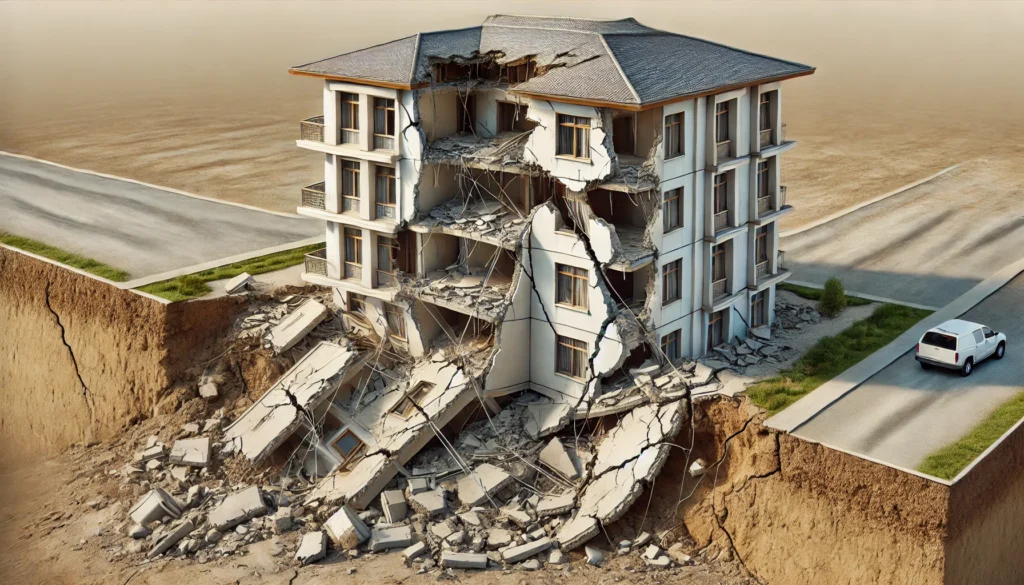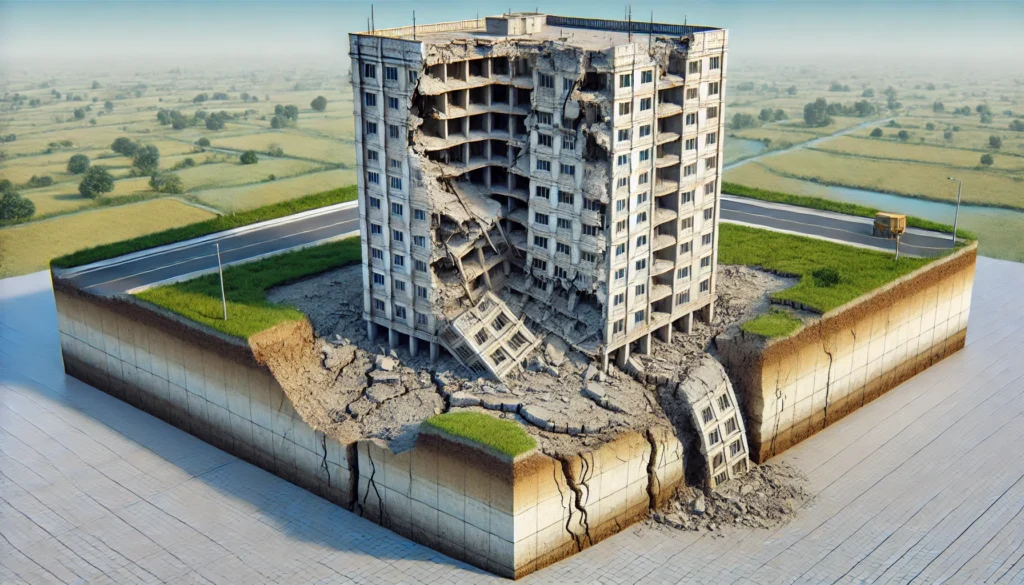Building settlement is a natural process that occurs over time as the weight of a structure compresses the soil underneath it. However, not all settlement is equal. Some settlement is expected and harmless, while others can lead to structural damage. In this comprehensive guide, we’ll explore the causes, types, and effects of building settlement, how to check for it, and what strategies you can implement to mitigate its impact.
Whether you’re a property owner, construction professional, or just curious, understanding building settlement is crucial to maintaining the structural integrity of any building.
What is Building Settlement?
Building settlement refers to the downward movement of a structure due to the compression or shifting of the soil beneath it. This is a common phenomenon in construction, particularly in buildings situated on weaker soil or those subjected to varying environmental conditions.
While some settlement is normal and occurs as the soil adjusts to the weight of a building, excessive or uneven settlement can be problematic. This can result in cracks in the foundation, walls, or floors, leading to costly repairs or even a compromised building structure.
Causes of Building Settlement
1. Soil Composition
One of the primary causes of building settlement is the type of soil on which the building is constructed. Clay soils, for example, are highly compressible and can shrink or swell based on moisture content, leading to significant settlement over time.
2. Changes in Moisture Levels
Fluctuating moisture levels in the ground can cause soil expansion or contraction. During dry seasons, soils can shrink, causing the foundation to sink. Conversely, in wet conditions, soils may swell, pushing the foundation upwards.
3. Load Distribution
An uneven distribution of weight in the structure, such as areas with higher loads, can result in differential settlement. Buildings with poorly distributed structural loads may experience sections settling at different rates, leading to uneven floors and structural stress.
4. Poor Foundation Design
A weak or inadequately designed foundation can be a significant factor in excessive settlement. Buildings with improper foundations may not be able to distribute the weight evenly across the soil, leading to faster settlement in some areas.
5. Nearby Construction Activity
Construction activities in nearby areas can disturb the ground and soil composition, causing movement beneath existing buildings. The vibrations and soil shifting caused by excavation, drilling, or piling can trigger unexpected settlement.
Types of Building Settlement in Construction
1. Uniform Settlement
Uniform settlement occurs when the entire structure settles evenly at the same rate. Although this is the least dangerous type of settlement, if it exceeds allowable limits, it can still cause damage to the building.
2. Differential Settlement
This occurs when different parts of the building settle at different rates. It is the most problematic type of settlement, as it can lead to structural distortions like cracked walls, tilted floors, and even foundation failure.
3. Immediate Settlement
Immediate settlement takes place shortly after the construction of a building. This is usually caused by the consolidation of soil under the building load and happens quickly, often within the first few years of construction.
4. Consolidation Settlement
This occurs over time due to the expulsion of water from the soil beneath the foundation. It’s common in saturated clay soils and can happen over a long period, leading to gradual sinking of the structure.
5. Creep Settlement
Creep is a slow, continuous type of settlement that occurs over an extended period due to long-term loading. It happens even after the construction is complete and can be difficult to detect in the short term.
Effects of Building Settlement
1. Structural Damage
One of the most immediate effects of building settlement is visible damage to the structure. This can include cracks in walls, ceilings, or floors, and can escalate if left unaddressed.
2. Tilted Floors
In cases of differential settlement, floors may become uneven or tilted, making it difficult to use the space effectively and potentially leading to further structural stress.
3. Damage to Utilities
Settlement can disrupt underground utilities such as plumbing and electrical lines. This can result in leaks, breakages, or loss of utility services in extreme cases.
4. Reduced Property Value
A building showing signs of significant settlement can suffer from reduced property value. Buyers and investors often see settlement issues as a red flag due to the potential cost of repairs and structural risks.
How to Check for Settlement of a Building
1. Check for Visible Cracks
Cracks in the foundation, walls, or floors are usually the first signs of settlement. Vertical cracks are common, but diagonal or stair-step cracks can indicate differential settlement.
2. Monitor Doors and Windows
If doors and windows are difficult to open or close, it might be due to the warping caused by settlement. Misalignment of frames can be a good indicator of movement in the structure.
3. Uneven Floors
Check for sloping or uneven floors by placing a ball or level tool on the ground. If it rolls or shows significant deviation, it could signal settlement issues.
4. Foundation Inspection
Regularly inspect the foundation for any signs of sinking, cracking, or displacement. Any movement in the foundation should be addressed immediately by professionals.

Mitigation Strategies for Building Settlement
1. Soil Testing and Site Preparation
Before construction, thorough soil testing can help identify potential issues that may lead to settlement. Engineers can then recommend suitable foundation designs to mitigate these risks.
2. Proper Drainage Systems
Implementing a well-designed drainage system can prevent water accumulation around the foundation, which is a common cause of soil shifting and settlement.
3. Piling and Ground Stabilization
In areas with weak or unstable soils, installing deep foundation piles or ground stabilization techniques can prevent settlement by transferring the building load to more stable layers of soil.
4. Regular Building Inspections
Regular inspections can help identify early signs of settlement before they lead to significant damage. Routine maintenance ensures that any issues are addressed promptly, preventing costly repairs.
Pro Inspect Solution: A Leader in Building Inspections
Pro Inspect Solution is a trusted name in the field of property and structural inspection services in Malaysia. Specializing in identifying settlement issues, they offer comprehensive assessments and expert recommendations to ensure the longevity and safety of your buildings. With state-of-the-art technology and an experienced team, Pro Inspect Solution provides solutions for settlement problems, helping property owners maintain structurally sound buildings.
For more information, visit Pro Inspect Solution.
Conclusion
Building settlement is an inevitable process in construction, but understanding its causes and types can help in preventing serious damage to structures. Regular monitoring and professional inspections are key to maintaining the integrity of a building and preventing costly repairs down the road. By implementing proper foundation design, soil testing, and drainage solutions, you can mitigate the risks associated with building settlement.
FAQs
What is a settling building?
A settling building refers to a structure that is experiencing downward movement due to the compression or shifting of the soil beneath its foundation.
What are the types of building settlements in construction?
There are several types, including uniform settlement, differential settlement, immediate settlement, consolidation settlement, and creep settlement.
What is settlement of structure?
Settlement of a structure refers to the downward displacement caused by the soil under the foundation compressing over time due to the building’s weight.
How to check settlement of a building?
To check for building settlement, look for visible cracks, uneven floors, misaligned doors and windows, and inspect the foundation for any signs of sinking or displacement.
What is building settlement?
Building settlement is the gradual downward movement of a structure as the soil beneath it adjusts to the load of the building.
What is the type of settlement?
The types of settlement include uniform, differential, immediate, consolidation, and creep settlement, each with varying effects on a structure.


